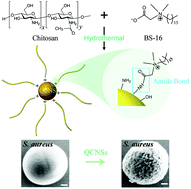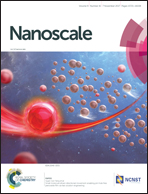Antimicrobial carbon nanospheres†
Abstract
Carbon nanomaterials have found numerous applications in various fields. However, their synthesis and functionalization usually require complicated procedures or tough experimental conditions. Herein, we report for the first time the synthesis of a new type of functional nanomaterial, quaternized carbon nanospheres (QCNSs), with superior antibacterial activity via a one-pot hydrothermal treatment of chitosan and hexadecylbetaine (abbreviated as BS-16). During the hydrothermal process, the direct reaction and carbonization between the amine-containing chitosan and the carboxyl-containing BS-16 were realized within only one step. The as-prepared QCNSs feature a well-defined spherical morphology and a homogeneous size distribution with an average diameter of ∼110 nm. In particular, the QCNSs could effectively kill Gram-positive bacteria with a minimum inhibitory concentration (MIC) of 2.0–5.0 μg mL−1. Meanwhile, the QCNSs showed excellent cytocompatibility towards normal human liver and lung cells and good hemocompatibility towards red blood cells. Moreover, in bacteria-infected macrophage cells, the QCNSs could selectively kill bacteria while the macrophage cells remained unaffected, which further confirmed their biocompatibility. Besides, we have also elucidated the antibacterial mechanism of the QCNSs by disrupting the bacterial cell walls/membranes via the bacterial adsorption and insertion of the long alkyl chain-containing quaternary ammonium groups on the particle surface. The present work provides a novel method for the preparation of functional carbon nanomaterials, which may promote the development of metal-free antibacterial agents.



 Please wait while we load your content...
Please wait while we load your content...